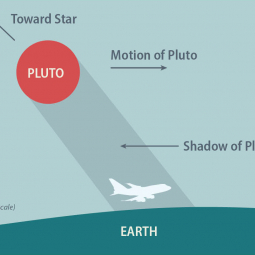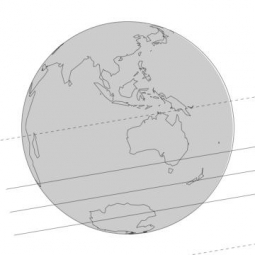In a special celestial event visible only from the Southern Hemisphere, Pluto passed directly between a distant star and the Earth on the morning of June 30, New Zealand time (June 29 in the U.S.). As the dwarf planet and its atmosphere were backlit by the star, this “occultation” caused a faint shadow of Pluto to move across the surface of Earth at more than 53,000 mph, creating a ripe opportunity to perform scientific analysis – if instruments and observers could be in the right place at the right time. The only observatory capable of positioning itself above terrestrial weather and directly in the center of Pluto’s shadow was NASA's SOFIA, a Boeing 747SP jetliner modified to carry a 100-inch (2.5-meter) diameter telescope built by NASA’s partner, the German Aerospace Center.
SOFIA, the Stratospheric Observatory for Infrared Astronomy, is operating from a base in Christchurch, New Zealand between June 15 to July 24, 2015. Flying out of New Zealand enables SOFIA to study celestial objects that are more easily observed, or can only be observed, from southern latitudes. The occultation observations were conducted during one flight in the observatory's science plan that includes studies of 40 celestial targets to be observed during a 15-flight program.
"SOFIA observations of Pluto demonstrate a capability to make detailed measurements of Pluto’s atmospheric density and structure," said Pamela Marcum, SOFIA Program Scientist at NASA’s Ames Research Center. "SOFIA conducted its first occultation observation, also involving Pluto, in July 2011. This flight adds to our understanding of how the atmosphere of Pluto evolves over multiple-year time scales as its elongated orbit takes it farther away from the Sun."
The occultation happened at a unique time, just two weeks before NASA's New Horizons mission will make its nearest approach to Pluto on July 14, 2015. New Horizons will use cameras, spectrometers, and other instruments to perform the first close-up studies of that world. Members of the New Horizons team who are co-investigators on the SOFIA observing proposal will have immediate access to the occultation data. Those data will be available to the general scientific community and the public in July 2016 via SOFIA’s scientific data archive.
"New Horizons will give us comprehensive 'snapshot' measurements of Pluto for which ongoing occultation studies provide context. This unique opportunity to connect what SOFIA observes remotely with in-situ measurements from New Horizons will allow future analyses of Pluto from Earth by SOFIA and other observatories to be considerably enhanced," Marcum said.
The principal investigator (P.I.) for these SOFIA occultation observations is Michael Person of MIT. Three scientific instruments were mounted together on SOFIA's telescope and used to make simultaneous measurements: HIPO (High-speed Imaging Photometer for Occultations; P.I. Ted Dunham, Lowell Observatory, Flagstaff, Arizona), FLITECAM (First Light Infrared TEst CAMera, P.I. Ian McLean, University of California, Los Angeles), and the FPI+ (Focal Plane Imager-plus, P.I. Juergen Wolf, German SOFIA Institute, University of Stuttgart). Speaking for the entire team, Ted Dunham said, "Lowell Observatory's Discovery Channel Telescope made last-minute precise measurements of Pluto's position that were analyzed at MIT and relayed to us on SOFIA. A 135 mile (220 km) shift in SOFIA's flight path was worked out and precisely executed. Thanks to the hard work and dedication of so many people, excellent data were obtained with all three instruments, including observing a flash at the moment the star was exactly centered behind Pluto and illuminated its entire atmosphere as a bright ring."
SOFIA is a joint project of NASA and the German Aerospace Center (DLR). The aircraft is based at NASA's Armstrong Flight Research Center facility in Palmdale, California. NASA’s Ames Research Center in Moffett Field, California is home to the SOFIA Science Center that is managed by NASA in cooperation with the Universities Space Research Association headquartered in Columbia, Maryland, and the German SOFIA Institute at the University of Stuttgart.
Video about SOFIA’s 2015 Southern Hemisphere deployment .
Articles by journalists onboard the occultation flight:
I Chased Pluto’s Shadow Across the Southern Pacific Ocean
Out of Christchurch, NASA's SOFIA Observatory successfully monitors stellar occultation by Pluto
View SOFIA's Pluto Occultation Observation video below:
Points of Contact
Nicholas A. Veronico
SOFIA Science Center, NASA Ames Research Center, Moffett Field, Calif.
650-224-8726
nicholas.a.veronico@nasa.gov
/
nveronico@sofia.usra.edu
Kate K. Squires
Armstrong Flight Research Center, Edwards, Calif.
661-276-2020
kate.k.squires@nasa.gov


